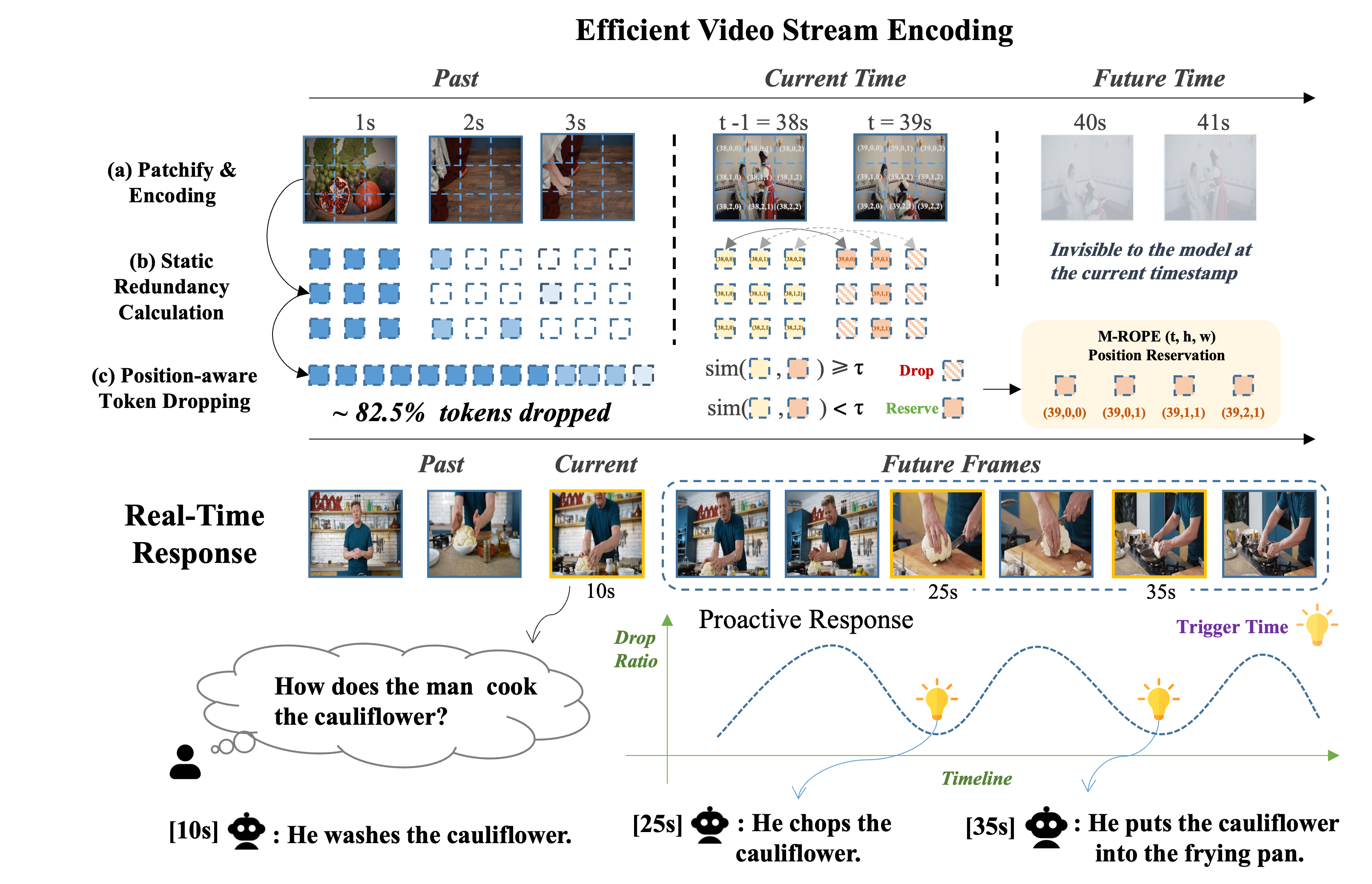🔗 Project Page · 📖 Paper · ⭐ GitHub · 📊 Dataset · 🤗 Checkpoints
📰 News
- [2025-06-10] Released the online demo code in a streaming manner.
- [2025-05-08] Released the annotation files and started to upload video frames of the TimeChat-Online-139K dataset.
- [2025-05-07] Our model checkpoints, training code, and eval code are now available.
- [2025-05-01] Our paper and project page are now available.
TimeChat-Online is a novel online VideoLLM designed for efficient streaming video understanding. Its core innovation, the Differential Token Drop (DTD) module, tackles visual redundancy by selectively preserving only meaningful temporal changes while eliminating static content between frames. Our experiments show that over 80% of streaming video content is naturally redundant without requiring user-query guidance.
✨ Video-aware Dynamic Pruning: DTD adaptively reduces video tokens from a holistic video perspective, well-suited for both high-speed and slow-motion videos.
📝 Positional Reservation: DTD maintains the fine-grained spatial-temporal positions of retained tokens via M-ROPE, ensuring precise spatial localization and temporal understanding capabilities.
⚡ Streaming-friendly Design: DTD efficiently processes video streams by calculating redundancy only for newly-arriving frames, without re-processing historical video content.
🎉 Proactive Response Capability: TimeChat-Online naturally monitors video scene transitions through the DTD module, enabling autonomous identification of critical moments that require responses without explicit queries.
- 🏆 StreamingBench: Achieves 56.6 accuracy with 82.6% token reduction (new SOTA)
- 🏆 OVO-Bench: achieves 45.6 accuracy with 84.8% token dropped (new SOTA)
- 🏆 Long Video Benchmarks (MLVU, LongVideoBench, VideoMME): Up to 85.0% reduction in video tokens while maintaining or improving performance
- 🏆 Zero-shot Integration: When integrated with Qwen2.5-VL-7B without training, DTD improves VideoMME (long subset) accuracy by 5.7 points while reducing 84.6% of video tokens
conda create --name TimeChatOnline-eval python=3.10
conda activate TimeChatOnline-eval
pip install -r requirement.txtfrom transformers import AutoProcessor
from qwen_vl_utils import process_vision_info
import time
from datetime import datetime
import torch
#pay attention to this line, not import from transformers, import from our GitHub repo's eval folder qwen2_5_vl
from eval.qwen2_5_vl import Qwen2_5_VLForConditionalGeneration
curr_time = datetime.now().strftime("%Y%m%d_%H%M%S")
DROP_METHOD = 'feature'
DROP_THRESHOLD = 0.5
DROP_ABSOLUTE = True
DR_SAVE_PATH = "drop_{curr_time}.jsonl"
# default: Load the model on the available device(s)
model = Qwen2_5_VLForConditionalGeneration.from_pretrained(
"wyccccc/TimeChatOnline-7B", torch_dtype=torch.bfloat16, attn_implementation="flash_attention_2",
device_map="cuda:0",
)
processor = AutoProcessor.from_pretrained("wyccccc/TimeChatOnline-7B")
messages = [
{
"role": "user",
"content": [
{
"type": "video",
"video": "file://your_video_path.mp4",
# "min_pixels": 336*336,
# "max_pixels": 336*336,
# "max_frames": 1016,
# "min_frames": 4,
# "fps": 1.0
},
{
"type": "text",
"text": "Describe this video."
},
],
}
]
# Preparation for inference
text = processor.apply_chat_template(
messages, tokenize=False, add_generation_prompt=True
)
image_inputs, video_inputs = process_vision_info(messages)
inputs = processor(
text=[text],
images=image_inputs,
videos=video_inputs,
padding=True,
return_tensors="pt",
)
inputs = inputs.to("cuda:0")
# Inference: Generation of the output
generated_ids = model.generate(
**inputs,
max_new_tokens=128,
drop_method=DROP_METHOD,
drop_threshold=DROP_THRESHOLD,
drop_absolute=DROP_ABSOLUTE,
dr_save_path=DR_SAVE_PATH,
)
generated_ids_trimmed = [
out_ids[len(in_ids) :] for in_ids, out_ids in zip(inputs.input_ids, generated_ids)
]
output_text = processor.batch_decode(
generated_ids_trimmed, skip_special_tokens=True, clean_up_tokenization_spaces=False
)
print(output_text)For flexible real-time interaction, we introduce a comprehensive streaming video dataset with backward-tracing, real-time visual perception, and future-responding scenarios.
- 11,043 visually informative videos (average duration: 11.1 minutes)
- 139K question-answer pairs covering backward tracing, real-time visual perception, and forward active responding
- Average of 87.8 scene-oriented key frames per video (~7.14 seconds between consecutive frames)
We release the extracted video frames at 1 fps here and the question-answer pairs here.
We utilize the ms-swift framework for model training. Please note that the training script requires modifications to both ms-swift and transformers code. For detailed instructions, refer to the guidelines in train/readme.md before execution.
For detailed evaluation procedures, please refer to eval/readme.md.
For detailed demo information, please refer to demo/README.md.
If you find our work helpful, please consider citing:
@misc{timechatonline,
title={TimeChat-Online: 80% Visual Tokens are Naturally Redundant in Streaming Videos},
author={Linli Yao and Yicheng Li and Yuancheng Wei and Lei Li and Shuhuai Ren and Yuanxin Liu and Kun Ouyang and Lean Wang and Shicheng Li and Sida Li and Lingpeng Kong and Qi Liu and Yuanxing Zhang and Xu Sun},
year={2025},
eprint={2504.17343},
archivePrefix={arXiv},
primaryClass={cs.CV},
url={https://arxiv.org/abs/2504.17343},
}
- The data, code, and checkpoints are intended and licensed for research use only
- They are restricted to uses that follow the license agreements of the respective datasets and models used in this work
We thank the following projects for their contributions: TimeChat, Qwen2.5VL, RLT, VideoLLM-online, OVOBench, StreamingBench
